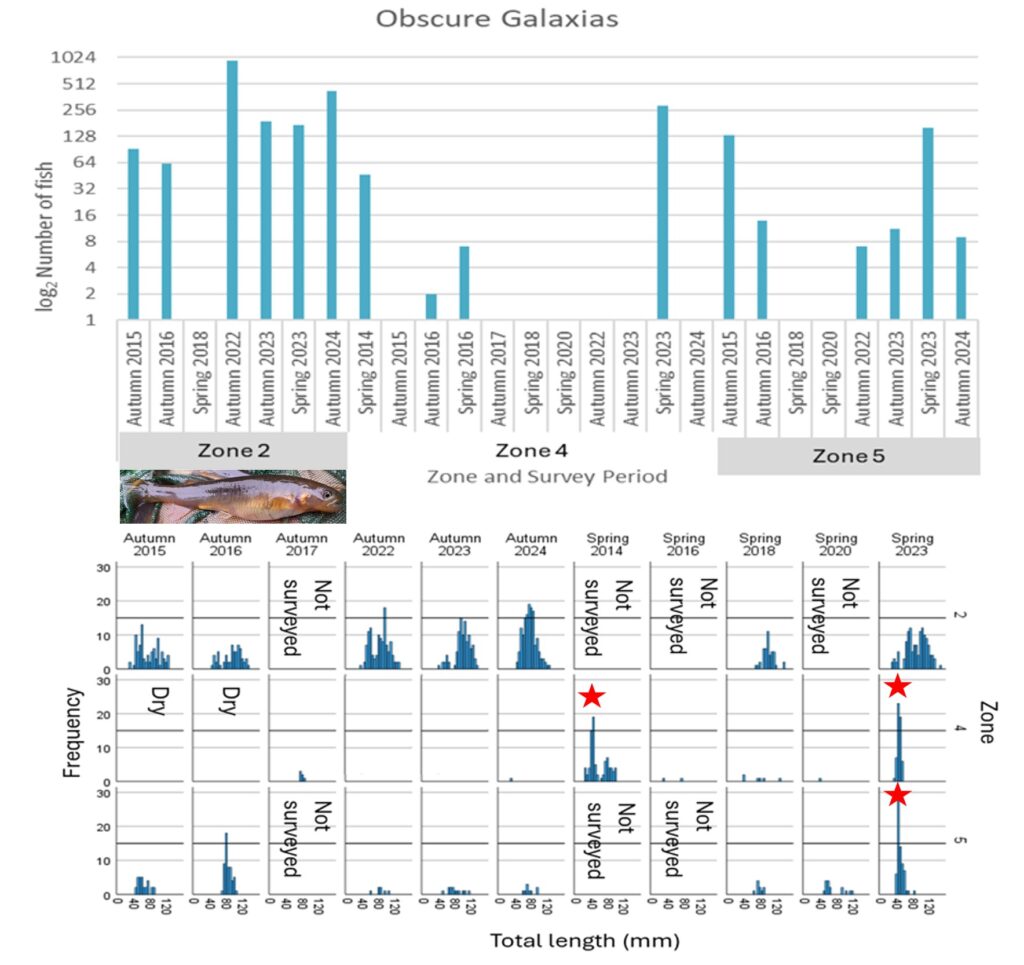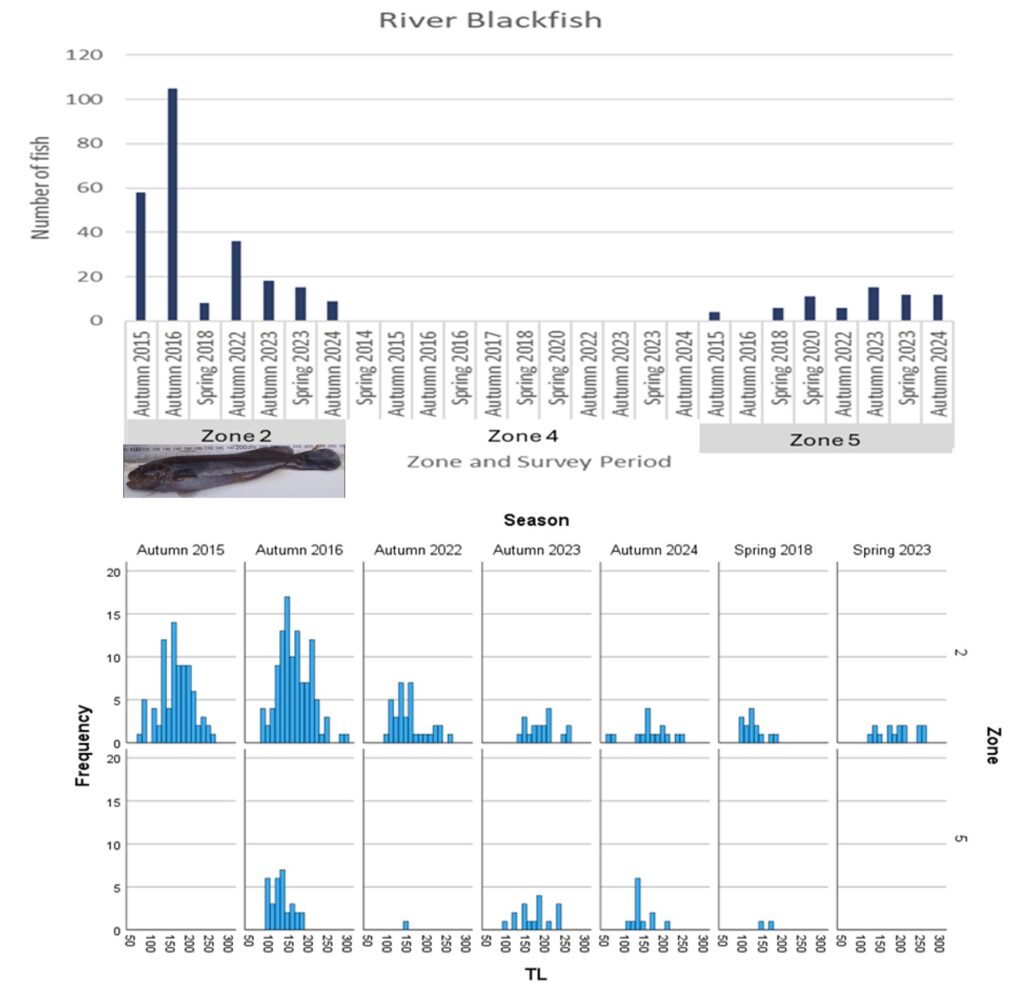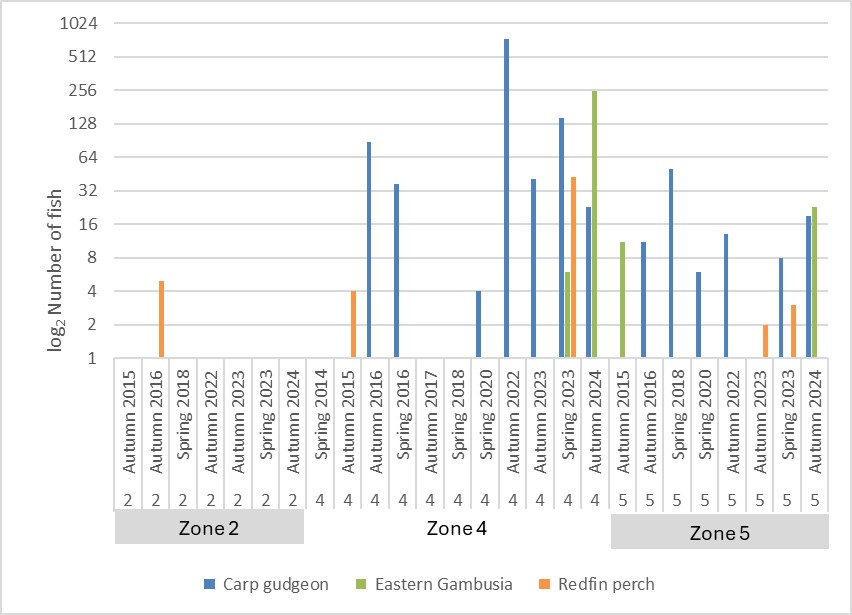Wannon River Insights Part 4 – Long-term study of freshwater fish of the upper Wannon River
Over the past three years, as part of an investigation into the ecology and hydrology of the Wannon River, whose catchment begins in the Grampians National Park in Victoria, we’ve had the opportunity to really grow our understanding around freshwater fish distribution and movement in the upper Wannon. Our initial understandings stem from work which first kicked off in 2016 when Lauren Brown was on the search for drought refuge. Through this initial work we began to realise the importance of this section of river for River Blackfish and Glenelg Spiny Crayfish. Since then we have popped in and out when time (and funding) has allowed, and now have a fuller picture across both high and low flow seasons.
Native and Introduced Freshwater Species
We have encountered ten species of fish, four species of crayfish and also long-necked turtles throughout the upper Wannon River, from Dunkeld to Jimmy Creek. Over that time we have seen some introduced species (e.g. Eastern Gambusia and Redfin) disappear and then reappear following catchment-wide flooding. We have also seen the numbers of native fish rise and fall, and with this longer-term data are starting to get a better picture on how some species move throughout the river system, where they breed and where they hunker down when things dry out. The following article summarises our key findings to date
Dividing the Catchment into Ecohydrological Zones
Our current understanding of the upper Wannon River focuses on five ecohydrological zones. Each zone exhibits a unique interplay between geomorphology (the evolution of surface features), geology and hydrology and gives rise to a suite of ecological values. The ecological values are specifically plant communities and habitat types. These values are consistent across a particular zone but different from other zones. In teasing apart our long-term fish survey dataset, we have used these zones (see below) to determine fish distribution throughout, and movement patterns between, these zones.
Distribution and Abundance of Southern Pygmy Perch
Of the native species, Southern Pygmy Perch (Nannoperca australis) are the most abundant and wide-spread species across all zones. Their numbers have remained fairly consistent in the upper and lower zones (2 and 5 respectively), particularly through Autumn surveys when zone 4 dries out and numbers decline. While the largest catch was back in Brady Swamp in 2014 (the first spring following our restoration trial), the most recent surveys (2023 and 2024) have yielded the highest catch of this species since, with a particularly strong increase in the headwaters (zone 2). Of particular note is the number of young fish (<30 cm) which made up the bulk of the catch in the wetlands of zone 4 (marked with a red star in the figure below), highlighting the important role these wetlands play in recruitment of the species. In Autumn this year, 2,500 Southern Pygmy Perch were captured in just one net in zone 2. This was the most downstream site in that zone and sampling occurred just after a rainfall event and initial flow pulse, which probably indicates that these fish were making their way upstream, presumably from the downstream recruitment sites/wetlands.

Distribution and Abundance of Obscure Galaxias
The second most abundant and widespread species is the Obscure Galaxias (Galaxias oliros). They occur more frequently in the upper zone (2) but had a more widespread distribution in the most recent surveys (2023 and 2024). This likely reflects the impact of higher flows (which occurred in 2022) and the downstream (involuntary) movement of fish from the headwaters. Similarly to Southern Pygmy Perch, juveniles (<5o mm) are proportionally more abundant in the downstream zones (4 and 5) than in the headwater zone (2), while larger fish are more abundant in the headwaters. While we haven’t detected juvenile fish on the move, this pattern of more adult fish in the headwaters and more juvenile fish downstream supports the likelihood of this species undertaking defined upstream movements as juveniles (see Raadik, 2014).

Distribution and Abundance of River Blackfish
River Blackfish (Gadopsis marmoratus) are a less mobile species, with individual fish spending their entire life within a 20 to 30 meter home range. This has obvious implications in systems which dry out because fish are less likely to move and find refuge pools. They also lay their eggs in hollow logs and, across their range, have been affected by the removal of woody debris from streams and also by suspended solids entering the waterway, which suffocates eggs. The catchment of the upper Wannon River, within the Grampians – Gariwerd National Park is pristine and the in-stream conditions are perfect for blackfish, as long as the pools don’t dry out.
The long-term data trend shows abundances are much lower now than they were back in 2015 and 2016. These higher catch rates were due to the system being very dry in 2015 and at the start of 2016, with the river ceasing to flow and pools concentrating down to low-levels (see zone 2 pool photo below). As a result of this contraction in habitat, most of the Blackfish captured in 2016 came from a single pool in zone 2. In zone 5, similarly, there is a pool which is sustained by groundwater and holds its depth even during dry spells. Sixty of the 66 recorded Blackfish captures from zone 5 occurred from this pool.
Long-term population health is difficult to assess, given the effect of pool drying and fish concentration. However, size classes (length frequency) indicate ongoing recruitment with both small and large fish being detected, which is great news for now. This tells us that this species seems to be hanging on in the upper Wannon River.
Even so, it can still be very difficult to determine how close we are to a tipping point where their persistence is threatened. Localised populations of these species have disappeared in other catchments, over the course of only a few years. This means that regular monitoring is very important, and that in light of the threatening processes which are also active in the Upper Wannon River (see previous Wannon insights article), we should not get complacent around their security.


Distribution and Abundance of Yarra Pygmy Perch
The most restricted species in the upper Wannon River is the Yarra Pygmy Perch (Nannoperca obscura). This species has so far only been detected at one location. There are some historical records for this species close to where we found them. The paper accompanying these observations refers to the catch location as “a small swamp in the Wannon catchment”, but the coordinates provided in the paper correspond to Dwyers Creek, over the other side of Mirranatwa Gap, with only Southern Pygmy Perch recorded at (or at least near) the Lynchs Crossing site in this historical study. At the site we have been studying, numbers have been down in recent seasons, following high flows in spring 2022. After these flows, the surrounding wetland was inundated through until late spring 2023 and the high connectivity this provided with the wider floodplain may have encouraged movement away from this refuge site. Whilst we did undertake a fairly extensive search for nearby refuge sites in 2016, a wider and more extensive hunt is still needed and something I’m keen to follow up.

Introduced species
Exotic species fluctuate across seasons but are more prolific in the lower reaches. Pleasingly, the upper zone (2) has had no exotic species detected since initial surveys in 2016. I have caught Brown Trout up here in the past, prior to the millennium drought. However, following high catchment runoff in 2022, both Redfin Perch and Eastern Gambusia have re-established in zone 4 wetlands and zone 5 pools. I even found a dead Rainbow Trout (a decent size one too!) below Brady Swamp in late 2022. The zone 4 wetlands are currently drying down during this current dry period and this, combined with a concentration of piscivorous bird species, will help keep these outbreaks in check.
The good news from this long-term study is that the native fish community is holding on. Through incorporation of environmental considerations in headwater water diversion timing, we can help to keep it this way.
This project was supported by the Australian Government’s Australian Heritage Grants Program 2020-21.



